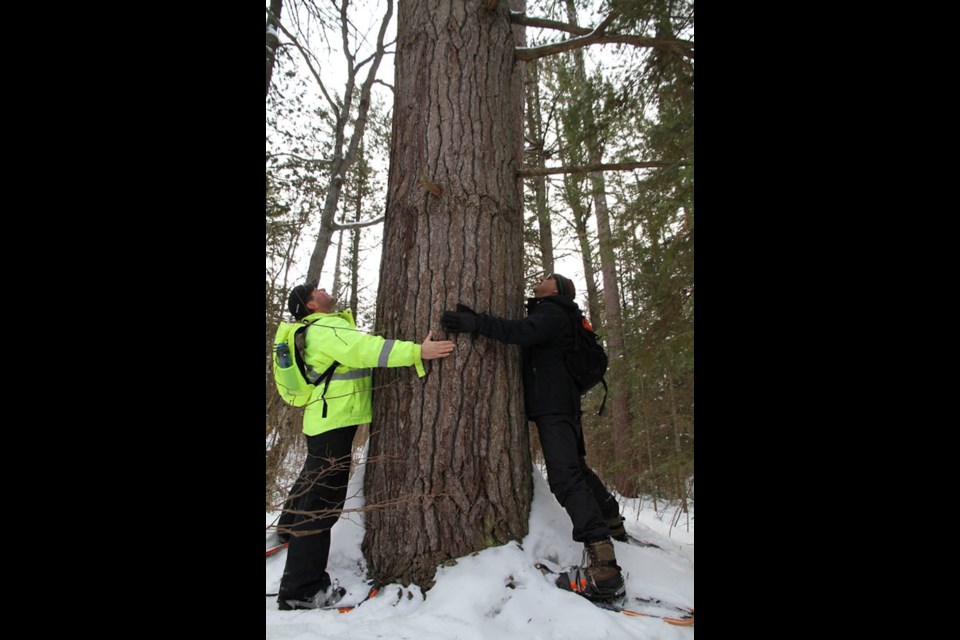Tall trees make you look up. Those asymmetrical crowns are unmistakable. But what about those twisted ones that aren’t so straight?
Wherever you are in Northern Ontario the majestic white pine will speak to you. Where is the largest white pine anyway? You can now go on a treasure hunt to find the tallest or widest.
Trees are our largest plants and it is not hard to identify the white pine from near or afar. We learn to differentiate the white pine from its close cousins by its characteristic bundle of five long needles corresponding with the five letter word, “w-h-i-t-e.” In the upper part of the tree the branches ascend, giving a broadly oval flat-topped outline which often becomes irregular, or asymmetrical, attributed to the effect of the prevailing northwest winds.
The white pine was the iconic symbol and the crux of the 'old growth’ controversy in the late 1980s. The photo of not-yet-premier Bob Rae and the recently deceased Chief Gary Potts on the Red Squirrel Road, just north of Temagami, remain as images of empowerment. In 1989, more than 300 people were arrested blockading the logging road construction. The road was opposed by First Nations, environmentalists, local residents and the tourism industry. The road would have opened the way to pristine wilderness, threaten the protection of Lady Evelyn-Smoothwater Park and allow logging of ancient stands of old-growth red and white pine.
Another bellwether issue was located at Owain Lake, south-east of Temagami in the 1990s. According to the Earth Roots organization it is the third-largest old-growth red and white pine forest remaining on the planet.
The Group of Seven artists epitomized the majestic and stately appearance of the tree. But white pines vary in height and shape, often with many stems and with twisted or crooked trunks often called “field” or “wolf” pines. It is because of an insect.
Fred Pinto knows a great deal about white pine and weevils. He is a Registered Professional Forester and is the executive director and registrar of the Ontario Professional Foresters Association. Prior to his current job, Fred worked for over 30 years with the Ontario Ministry of Natural Resources and Forestry in various capacities including the development of guidance for professional foresters in developing harvest and regeneration practices for a variety of forest ecosystems including those with white pine.
“The white pine weevil lays its eggs on younger and shorter pines. Weevils overwinter in the undecomposed litter on the forest floor,” he said. “The female has to climb to the leader to lay her eggs in the spring. The weevil becomes abundant when the pine are growing in open conditions where light levels are high and temperature and relative humidity varies widely daily and through the seasons. Weevil damage is less in taller trees.”
“Trees are adapted to grow towards light. When the main stem's tip — alled the leader — is killed, the hormonal control that the tip exerts over the other branches is released. This causes the other branches to grow up towards the light. It may take several years for one of these branches to become a new leader. So these trees with multiple leaders take on a shaggy appearance."
The tops of large pine trees may be also affected by white pine blister rust which you can see oozing out of the trunks. It is a fungal disease that was introduced to North America.
The disease causes the top or branches to die off. White pine blister rust is a novel fungus to white pines in North America just like COVID-19 is a novel virus for humans. This fungal disease has been spreading across North America and has now reached western North America where it is affecting Western white pine, a pine species found at high elevations in the west.
Do trees put on girth over height as they age? It is not straight forward he said.
“Short answer: Trees are unable to move like animals, so to ensure that they can withstand wind, ice etc. they tend to change their structure and wood composition. Trees will increase their girth and produce different wood to withstand the buffeting wind. Also, the girth of trees is more related to how well they are able to access resources. So trees with wider girths tend to be open-grown.“
You will see many stately trees at 90-100 cm in diameter. Over one metre you are looking at trees at an age of 300 years plus.
Whether you have a GPS unit or on your cell you can participate in this treasure hunt by the anecdote. There are more candidates to add. See the map for specific trees and large stands and back roads vistas.
You can measure the diameter at what is called “dbh” (diameter at breast height, 1.34 m) with a flexible tape. You can estimate the height through Google: “determining the height of a tree.”
Location is important; submit to the author, maybe with a photo and it can be added to the map. At present the tallest tree in Ontario is located in Arnprior. It is 47 m with a dbh of 1.34 m. The former tallest fell down in 1998 and was located north of Thessalon. It was 49.4 in height with a dbh of 1.4 m.
